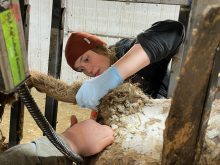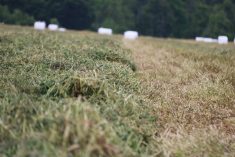Just like a beauty pageant, calf shows are only for the most beautiful animals.
Known as club calves, they may not have the best feed conversion efficiency or make the best herd sires but they do win show competitions.
“The whole purpose of breeding these is for shows,” said Raymond Gonnet of Iowa.
“They’re cardboard cutout cattle. They’re not practical cattle. They’re powerful and over the top. It’s all based on appearance. They have big bones, are really super thick and yet are still real attractive.”
Read Also

Environmental farm group has Ottawa’s attention
In 2021, Farmers for Climate Solutions published a report on how Canada should reduce emissions from agriculture. Not long after, the federal government implemented most of the recommendations in the report.
Gonnet, who is originally from Canada, raises, shows, sells and promotes club calves.
He started showing cattle in his local 4-H club in 1998 before he had seen the beauty queen calves. What he saw intrigued him, and by 2004, he and Dustin Lamb of Balzac, Alta., had teamed up to raise them.
“They’re not just an F1 cross. It has taken years to perfect their traits,” said Gonnet, who originally bred 150 cows solely for club calves.
“They’re designed to get you interested in showing cattle. A plain Jane calf out of your neighbour’s pasture is not as exciting as the named calves.”
Club cattle have become a breed of their own. They are big boned, medium-framed calves with plenty of hair to shape and sculpt.
Named calves come from club calf sires and can make bull owners millions of dollars. The winner of last year’s Calgary Stampede, Canada’s biggest jackpot purse, was from the bull Eye Candy.
All the steers at the jackpot steer show in Medicine Hat were calves from named club calf sires.
“They’re more than just a cross bred calf. They are a super breed for shows,” said Gonnet.
A popular club calf bull can easily sell 10,000 to 20,000 straws of semen at $25 to $250 a straw.
“You’re making bankroll,” said Gonnet.
Ryan Clark of Melville, Sask., whose family runs Clark Club Calves near Kipling, Sask., said the cattle are bred for phenotype.
“They have to have the show factor,” he said.
Club calves can be a mix of Maine Anjou, Chianina, Shorthorn, Angus, Galloway and Gelbvieh with no particular colour.
Calves with lots of long, thick hair are almost always a club calf feature, which allows fitters to clip and shape hair to perfection.
“It’s a game of who can make cattle look so much more perfect than they should,” said Gonnet.
Clark said raising club calves is a way for his family to add a little extra money to their cattle operation.
The former 4-H member’s calves are almost exclusively sold to 4-H members in Saskatchewan and Manitoba.
“In our operation, we focus on 4-H kids,” said Clark, whose family has shown cattle since his great-grandfather’s day.
4-H members who hope to win local or regional shows, such as a regional 4-H show in nearby Wey-burn, Sask., that is supported by the local oil industry, need a steer designed for the show circuit.
“To win that show means quite a bit of money,” said Clark, who has sold club calves since 2007.
“If you want to be in the top, you’ve got to have a club calf.”
Gonnet has sold 500 pound club calf steers for $30,000 in the United States, but he has seen similarly sized calves sell for up to $80,000 to people who hope to win lucrative calf shows where prize money reaches $100,000 or more.
“It’s so competitive,” he said. “The only way to win is to have a really, really good calf.”
Lamb said 200 of the cows in his herd are bred to club calf bulls with the hope of getting a $500 to $1,000 premium for the calves. The ones he doesn’t sell for show go into the family feedlot.
“The premiums have been good at times.”
He said club calves are required to win in the Canadian show ring.
“That’s what’s winning. The shows are dominated by clubby cattle,” said Lamb. “It’s just about always a clubby that is grand or reserve.”
Gonnet said it’s not uncommon for families to spend $10,000 or more to buy a club calf show steer to give them a chance of winning a local or state fair.
“There are a lot of competitive show families. Some families buy boats and campers, others buy $30,000 show steers,” said Gonnet.
“There is a lot of money being tossed around. A lot of $10,000 cattle might not win their class. There’s a lot of gambling involved. People do it for the glory of winning and the title and success.”
In Canada, the richest steer show is Calgary Stampede’s $10,000 pot.
Roland Schumaker, editor of The Show Circuit, a magazine dedicated to the cattle showing business, said lots of children and their families travel to shows every weekend during show season.
“The bigger the prize money, the tougher the competition.”
The Midwest states have a lot of shows, but Texas is still tops in the number of shows and prize money, with some shows offering $300,000 in prize and scholarship money.
Schumaker said many of the families involved come from a farm, but a growing number are families that live on a small acreage with enough land for a barn and a couple of show calves.
“In general, a lot of kids have ag backgrounds, but not all, by any means.”
Gonnet said the popularity of calf shows in the U.S. has always been large, but it is becoming more popular in Canada, especially for young people who enjoy travelling to cattle shows.
He travels to cattle shows every weekend helping trim and fit the calves he has sold to clients.
“It’s huge down here, enormous.”
He estimates that the club calf business in the U.S. is twice as large as the entire Canadian purebred industry.















